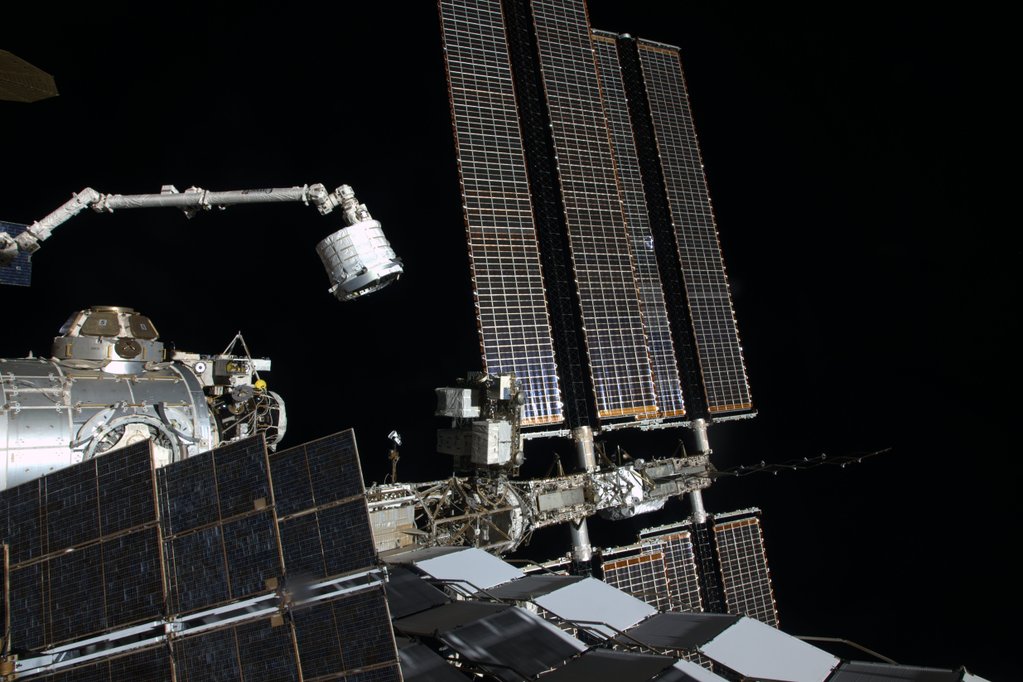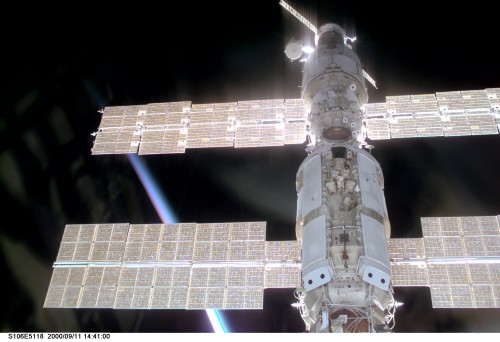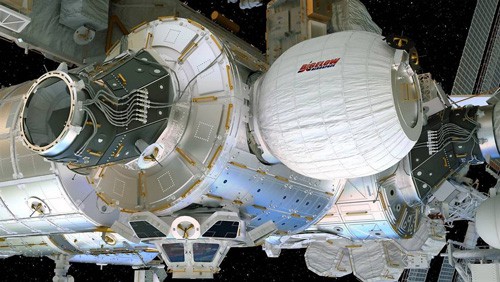
Depending upon how you count them, around 15 permanent pressurized modules now adorn the International Space Station (ISS), as the outpost enters its 19th year in orbit and its 17th year with a permanent human presence aboard. Last Saturday’s successful installation of the newly-arrived Bigelow Expandable Activity Module (BEAM)—the first human-rated expandable facility ever attached to an inhabited spacecraft—will provide an additional 565 cubic feet (16 cubic meters) of pressurized volume to the ISS. This is on top of the space station’s previous total of 32,300 cubic feet (916 cubic meters), afforded by a mixture of U.S., Russian, European, and Japanese modules. In fact, during the early stages of its on-orbit assembly, more than a decade ago, the ISS had already firmly established itself as the largest occupied spacecraft ever built.
The ISS, of course, can trace its ancestry back more than three decades, to President Ronald Reagan’s State of the Union address in January 1984, when he proposed a permanent, Earth-orbiting space station by the mid-1990s. Later renamed “Freedom”—having drawn in support from Canada, Japan, and the nation-states of the European Space Agency (ESA)—the proposed 31,000-cubic-foot (878-cubic-meter) station met with political and technical difficulty and suffered scathing budget cuts. After major restructuring, Freedom came within a hair’s breadth of cancelation in 1993. It was subsequently reborn, with Russian participation, as the seedling of today’s ISS, and after several years of additional delay its first module rose into orbit on 20 November 1998.

That module, Zarya (“Sunrise”), though Russian-built, was financed by the United States, following a February 1995 agreement between NASA and the Russian Space Agency (RSA). Alternatively known as the Functional Cargo Block (in Cyrillic characters, abbreviated as “FGB”), it was intended to serve as an early provider of electrical power, storage, propulsion, and guidance for the nascent ISS, before assuming backup Guidance, Navigation, and Control (GNC) capabilities as the station’s other capabilities arrived. Weighing 42,500 pounds (19,300 kg), Zarya finally arrived in orbit on 20 November 1998—a full year later than originally timetabled, due to ongoing ISS Program delays—and established the first foothold of the ISS, with an internal pressurized volume of 2,525 cubic feet (71.5 cubic meters). Two weeks later, the crew of shuttle mission STS-88 delivered the U.S.-built Unity module (also known as “Node-1”), and installed it onto Zarya. At each end of Unity was a Pressurized Mating Adapter (PMA), with PMA-1 at the Zarya “end” and PMA-2 at the space-facing “end” of the steadily growing ISS.
Totaling around 25,600 pounds (11,600 kg), Unity and its twin PMAs not only increased the station’s mass, but also served to significantly expand its pressurized envelope. The third permanent arrival came in July 2000, when the 44,800-pound (20,320-kg) Zvezda (“Star”) service module arrived, to provide early crew quarters and the station’s life-support apparatus, as well as forming the centerpiece of Russia’s contribution to the ISS. With Zvezda in place, an additional 3,140 cubic feet (89 cubic meters) of volume was afforded to the steadily growing international outpost.
However, it was the arrival of the 3,800-cubic-foot (106-cubic-meter) U.S. Destiny lab—the station’s primary command and control hub, as well as the central research facility for the U.S. Orbital Segment (USOS)—in February 2001 which pushed the pressurized extent of the ISS beyond the 12,360 cubic feet (351 cubic meters) of Russia’s Mir orbital complex. In fact, Destiny expanded the ISS by no less than 41 percent, raising its total pressurized volume to more than 13,000 cubic feet (370 cubic meters). It also tipped the scales at 224,000 pounds (101,600 kg), far higher than the 150,300 pounds (68,175 kg) of the United States’ mammoth Skylab space station of the 1970s. Moreover, through its longitudinal axis, taking in the Zarya, Zvezda, Unity, and Destiny modules, as well as the two PMAs, it ran to 171 feet (52 meters). This made it several times longer than the 62-foot (19-meter) longitudinal dimension of Mir and the 82-foot (25-meter) length of Skylab. Barely 27 months into its life, the ISS was growing into the largest habitable structure ever placed above Earth’s atmosphere.
But this was barely the beginning. In July 2001, the 21,880-pound (9,900-kg) Joint Airlock module, named “Quest,” arrived, with its equipment and crew locks increasing the station’s pressurized volume by a further 1,200 cubic feet (34 cubic meters). This was further expanded by Russia’s 7,900-pound (3,580-kg) Pirs (“Pier”) docking compartment, which reached the station and docked at the Earth-facing (or “nadir”) port of Zvezda in September 2001, adding about 460 cubic feet (13 cubic meters) of pressurized volume. All told, this left the ISS at about 15,000 cubic feet (420 cubic meters). Due to the February 2003 loss of Columbia, several years elapsed before the next permanent pressurized visitor arrived aboard Shuttle Discovery in October 2007. As well as providing a berthing interface for future modules, the Harmony node increased the station’s envelope by 20 percent, adding no less than 2,660 cubic feet (75.3 cubic meters) and raising its pressurized volume to more than 17,660 cubic feet (500 cubic meters).

Assembly accelerated, with Europe’s 22,700-pound (10,300-kg) Columbus lab adding 2,650 cubic feet (75 cubic meters) upon its arrival and attachment to the starboard side of Harmony in February 2008. Next came the 18,490-pound (8,390-kg) Experiment Logistics Module (ELM) and 35,100-pound (15,900-kg) Pressurized Module (PM) of Japan’s Kibo facility, which provided further “real estate” on the port side of the U.S. Orbital Segment (USOS) in March-June 2008. In fact, Kibo’s main module remains the largest single pressurized component of the ISS, measuring 36.7 feet (11.2 meters) long.
Subsequent modules included the Poisk (“Search”) module, a virtual twin of Pirs, which docked at Zvezda’s space-facing (or “zenith”) port in November 2009. Several months later, the Rassvet (“Dawn”) module also arrived and was attached to the nadir interface of the Zarya module. Closing out the United States’ list of major pressurized components, the Tranquility node—which reached orbit pre-integrated with the multi-windowed cupola—arrived in February 2010, adding over 2,650 cubic feet (75 cubic meters) to the station, and the Leonardo Permanent Multipurpose Module (PMM) was installed in February 2011 by the STS-133 shuttle crew. Previously flown on several occasions since March 2001 as a Multi-Purpose Logistics Module (MPLM), Leonardo provided more than 2,400 cubic feet (68 cubic meters) of volume for storage and supplies.
On the eve of BEAM’s arrival, therefore, the ISS totaled around 32,300 cubic feet (916 cubic meters) of pressurized volume, larger by far than any previous space station, and roughly comparable to a six-bedroom house. When BEAM is expanded from its “stowed” size of 5.7 feet (1.7 meters) long and 7.7 feet (2.4 meters) in diameter to its “deployed” size of 13 feet (4 meters) long and 10.5 feet (3.2 meters) in diameter, it will offer an additional internal volume of 565 cubic feet (16 cubic meters). Expansion of BEAM is tentatively scheduled for 27 May and, as outlined recently by AmericaSpace, may not be the last involvement in the ISS Program by Bigelow Aerospace. Under a recent agreement between the Las Vegas, Nev.-based aerospace firm and United Launch Alliance (ULA), the B330 expandable habitat is expected to undertake its first mission by 2020, with discussions ongoing with NASA and the International Partners over whether it may fly in conjunction with the ISS.
Other modules remain in the pipeline before the station’s currently timetabled end of operations in 2024. Of specific note is Russia’s long-delayed Nauka (“Science”) Multipurpose Laboratory Module (MLM), targeted to fly no sooner than 2017, which promises to provide 2,470 cubic feet (70 cubic meters) to the ISS when it docks at the nadir port of Zvezda. This will bring the pressurized area of the ISS to around 35,330 cubic feet, equivalent to more than 1,000 cubic meters. And despite the cancelation of numerous other facilities, including the Centrifuge Accommodations Module (CAM) and the Habitation Module (HAB)—which might have made this Earth-circling town even larger and more capable—it is important to reflect that the ISS remains not only one of the brightest-magnitude objects in the night sky, but several orders of magnitude ahead of its closest space station cousins of yesteryear.
Want to keep up-to-date with all things space? Be sure to “Like” AmericaSpace on Facebook and follow us on Twitter: @AmericaSpace






Thank you Ben Evans for another useful report on BEAM and the expandable ISS!
One may wonder how many decades the expandable ISS could last…
And maybe B330 expandable habs could get to the ISS on a new ORBITAL ATK heavy launcher…
“Orbital ATK officials said the company has three engine options for the new launcher’s upper stage, but officials consider the BE-3 engine the leading candidate.”
From: ‘Orbital ATK eyes Kennedy Space Center as home of potential new launcher’ By Stephen Clark April 21, 2016 At: SPACEFLIGHT NOW
Maybe the ISS could get a lot larger!